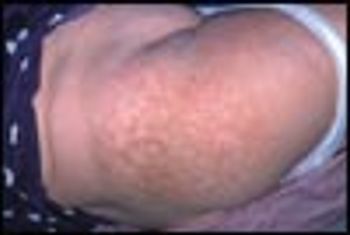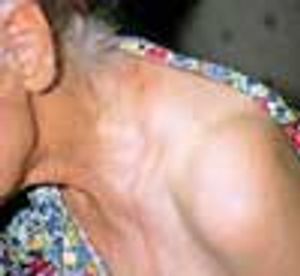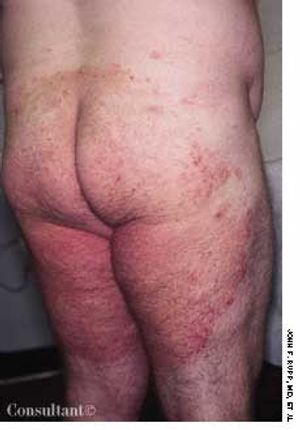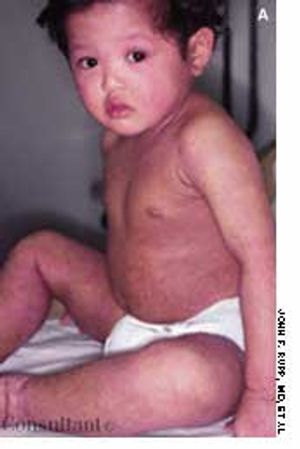
A 43-year-old woman with chronic hip pain presents with an asymptomatic eruption on the hip of several months' duration. She has been using a heating pad at night for pain relief because NSAIDs have not been effective.

A 43-year-old woman with chronic hip pain presents with an asymptomatic eruption on the hip of several months' duration. She has been using a heating pad at night for pain relief because NSAIDs have not been effective.

A Photo Quiz to Hone Dermatologic Skills

A 54-year-old woman presents with an asymptomatic rash of sudden onset on both malar cheeks that developed 1 day earlier. She denies any facial trauma.



A Photo Quiz to Hone Dermatologic Skills

For the past month, a 67-year-old woman has had a pruritic rash under her left breast. She takes an antihypertensive and is otherwise healthy.



Dermclinic: A Photo Quiz to Hone Dermatologic Skills

or several years, a 71-year-old man has had a pruritic eruption on both legs that occurs every winter and resolves in the spring. He is scheduled to undergo knee surgery, but the surgeon will not perform the operation until the rash has cleared. The patient has not used a new soap or changed his bathing habits recently.

A pruritic rash around the elbows; a soft, doughy papule; a slightlytender nodule with a keratotic core-do you recognize the disorderspictured here?

fill this in

For several months, a 68-year-old man has had a highly pruritic rash on his lower legs. A similar rash recently arose on his trunk and arms. Treatment with a corticosteroid cream has been ineffective. The patient has diet-controlled diabetes and hypertension that is well controlled by medication.


A 35-year-old woman has a lifelong history of recurrent blisters on the handsand feet that heal without scarring. No other family members have this condition,and she has no children. She is visiting your office for the first time toseek new treatment options.

For several weeks, a 68-year-old man has had painful blisterson his hands that crusted as they healed. The patienthas diabetes mellitus, hypertension, and chronic renalfailure, for which he is undergoing hemodialysis. His longtermmedications include a hypoglycemic agent and adiuretic.

Impetigo developed on the face of a 7-year-old boy who had chickenpox. Thepatient was given a 10-day course of oral cephalexin and mupirocin ointment;the infection resolved promptly.

This 2 1/2-year-old boypresents for evaluation ofan asymptomatic, nonpruritic,nonblanchable rashthat is primarily confined tohis cheeks. There is someerythema on the extensorsurfaces of the proximalextremities. The motherreports that the child hadan upper respiratory illnessabout 3 days earlier, withcough and a slight fever.He took no medication forthat illness. Because thesymptoms were so mild,she had not brought thechild in for medical attention.The rash appearedafter the fever and coughresolved. The child isotherwise healthy and hetakes no medication.

Smallpox, which is caused byinfection with poxvirus variola,may follow variouscourses. An erythematouseruption can precede theappearance of tense, deep-seatedpapules that rapidly transform intovesicles. The lesions may be sparseor so numerous that they becomeconfluent.

A 47-year-old woman is bothered by the numerous small, smooth, darkbrown papules that have developed on her face and neck during the pastdecade. She asks if the asymptomatic lesions can be removed.

A Photo Quiz to Hone Dermatologic Skills

An asymptomatic loss of pigment around the eyelids of several weeks' duration prompts a 53-year-old woman to seek evaluation. She has not started wearing any new eye makeup; her only medication is an antihypertensive.

An asymptomatic loss of pigment around the eyelids of several weeks' duration prompts a 53-year-old woman to seek evaluation. She has not started wearing any new eye makeup; her only medication is an antihypertensive.

For several months, a 56-year-old woman has noticed slowly progressive thickening of the skin on her volar wrists and shoulders that is associated with pruritus and loss of pigment. There is no personal history of trauma and no family history of similar lesions. She has taken the same statin for the past 3 years.

Slowly progressive depigmentation; asymptomatic petechiae; a mildlypruritic, crusty rash--do you know the cause of the disorderspictured here?

A 6-year-old boy has a rash on his hands and feet that erupted shortly after he started first grade. His parents are concerned that he may be allergic to something at school, such as chalk. He is otherwise healthy.

A Photo Quiz to Hone Dermatologic Skills

Pruritic eruptions on both arms of a 12-year-old who has played outdoors all summer; a rash on the hand of a teenage baseball player . . . might sports be responsible for these lesions?

An extensive, highly pruritic rash; hypopigmented macules; a scaly,pruritic plantar eruption that resists antifungals--can you identify thedisorders pictured here?

Published: September 15th 2006 | Updated:

Published: October 1st 2006 | Updated:

Published: November 1st 2006 | Updated:

Published: September 14th 2005 | Updated:

Published: September 14th 2005 | Updated:

Published: September 14th 2005 | Updated: